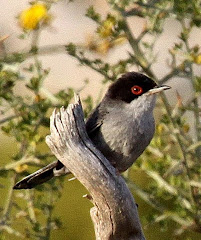.jpg)
October 30, 2010:
There has been a large influx of continental Waxwings into the country during the past week and by yesterday this flock in the village of Barrow near Clitheroe had rapidly built up to about 80 birds with more joining today. They appear to be early this autumn because when last here in 2008 they didn't arrive until mid-November. As was the case then, the great attraction is the line of heavily fruiting rowan trees running along one side of the village street.
.jpg)
.jpg)
The flock tended to split and re-form frequently with birds settling to feed greedily in the rowans for only a minute or two before wheeling away to perch for a while in taller trees elsewhere. Then they would be back again circling the area with a rather fluttering, distinctive flight whilst deciding in which rowan to feed. However, although most trees had abundant berries only a few were selected, presumably the birds knowing which were at the correct stage of ripeness. Occasionally they appeared to take flies whilst in the air. Today there were masses of fruits but one hundred-plus Waxwings will soon alter this and then move on elsewhere.
.jpg)
.jpg)
.jpg)

.jpg)
In the bright sunshine this morning the Waxwings were watched by a small group of people and even a local House Sparrow seemed to be impressed.
.jpg)
.jpg)
.jpg)
.jpg)
.jpg)
.jpg)
.jpg)
.jpg)
.jpg)
.jpg)
.jpg)
.jpg)
.jpg)
.jpg)
.jpg)
.jpg)
.jpg)
.jpg)
.jpg)
.jpg)
.jpg)



.jpg)
.jpg)
.jpg)
.jpg)
.jpg)
.jpg)
.jpg)
.jpg)
.jpg)
.jpg)
.jpg)
.jpg)
.jpg)
.jpg)
.jpg)
.jpg)
.jpg)
.jpg)
.jpg)
.jpg)



